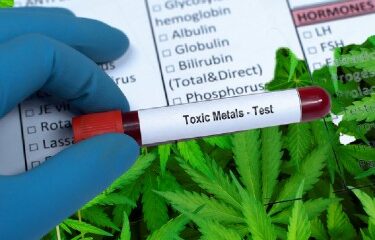Healthcare
What is a Rose Blunt and Should You Even Try to Roll One?

Do you know what a Rose Blunt is if you saw one?
There are dozens of ways you can smoke pot.
But have you ever tried adding flavor and aroma to your already delicious weed? It’s completely possible to do so, elevating the experience of smoking and making it all-around much more enjoyable. While there are many known ways of adding flavor to your weed, one of the lesser known methods is to make a rose blunt.
Why roses?
Roses already contain sweet terpenes, and when combined with the terpenes in marijuana, it heightens the sensation of smoking. Roses have already been used since ancient times as a beverage or food enhancer. For example, in North Africa, roses are part of a traditional spice mix known as ras en hanout. Meanwhile in Turkey, there are many rose-flavored foods. There are over 200 different kinds of rose species known today, and they can all produce a wide range of flavors such as sweet, spicy, minty, or sour.
There are other benefits to smoking rose petals with your marijuana. Aside from being healthier than tobacco fillers, rose petals are fragrant and enhance the aroma as well as taste. As long as you source it properly or grow it yourself, roses are organic and 100% free from chemicals.
Many blunt wraps and rolling papers these days are unfortunately laced with chemicals and other toxic compounds. Finding a way to make your very own can be rewarding. Fortunately, it’s fairly easy to find and use fresh rose petals as a blunt wrapper.
Additionally, rose petals add a feminine touch to smoking a blunt. Roses are well-known for their mood-enhancing properties, and can help provide relief from fatigue and insomnia.
Choosing The Best Roses
Sure, there are many different kinds of ready-made joint and blunt papers widely available today. But why not try making them out of roses? It’s completely organic and natural, provided that you are using a pesticide-free source and flowers that have been completely untreated – which is why it’s best if you actually grow your own or know a friend who does.
Don’t use store-bought roses, such as those that are sold in bouquets. These are filled with pesticides and other toxins that you don’t want in your system.
The best roses for rose blunts are those that have large petals. It should already be fully open and not have any holes.
Then follow these steps below:
- Dry the rose petals. Simply put 2 to 4 petals inside your oven or toaster at a time, ensuring they are evenly spaced. The petals have a high moisture content, and the water can make it difficult to smoke with – which is why drying them out is necessary.
The length of time required to dry them out in a toaster or oven will vary on the moisture content of your petals. Try heating them up for around 10 seconds at a time. What you are looking for is a texture that is dry enough that the petals could actually stick together, using the minimal moisture from their edges.
- Once the petals are dry enough, begin stacking them one on top of the other until you have the size and shape desired in a blunt. In the same way you would with rolling papers, lick the edges of the petals to help them stick together. This can take a few minutes.
Alternatively, you can dip one end of a cotton swab in water and gently rub it on the edges to help them stick. If you have sticky marijuana concentrates lying around, you can also use it instead of your own saliva. This will also help make you even higher!
- Once you’ve got the petals rolled up and stuck together, fill it up with weed. Again, the same way you would with a regular joint and rolling paper.
If you don’t have access to fresh roses but you do to dried rose petals, you can also make an alternative type of rose blunt.
All you need to do is to sprinkle some dried rose petals on top of the weed in your blunt. You can also run the dried rose petals through a grinder; this way it’s finer and easier to smoke. Close your blunt and seal it the way you normally do, and smoke.
Allergic Or Not A Fan Of Roses?
Some people don’t like the smell or taste of roses. It isn’t for everyone.
However, that doesn’t mean that you can no longer enjoy botanical-infused joints or blunts. There are several other types of herbs and plants that you can use as a topping to your joints, such as:
- Lavender
- Raspberry leaf
- Passionflower
- Lion’s tail
- Blue lotus
- Chamomile
- Jasmine
Additionally, take note of flowers that can be toxic. Don’t use these flowers for smoking – or eat them at all:
- Oleander
- Rhododendron
- Lily of the valley
- Azaleas
- Daffodils
Conclusion
Mixing up your cannabis smoking experience with the use of flowers and herbs is a safe, natural way to elevate your experience. Smoking a rose blunt is also a great way to mark a special celebration especially with your loved ones, or set a romantic tone with your partner.
Just be sure to do your research carefully to ensure you aren’t consuming anything that is toxic.
Source: https://cannabis.net/blog/how-to/what-is-a-rose-blunt-and-should-you-even-try-to-roll-one
Business
New Mexico cannabis operator fined, loses license for alleged BioTrack fraud

New Mexico regulators fined a cannabis operator nearly $300,000 and revoked its license after the company allegedly created fake reports in the state’s traceability software.
The New Mexico Cannabis Control Division (CCD) accused marijuana manufacturer and retailer Golden Roots of 11 violations, according to Albuquerque Business First.
Golden Roots operates the The Cannabis Revolution Dispensary.
The majority of the violations are related to the Albuquerque company’s improper use of BioTrack, which has been New Mexico’s track-and-trace vendor since 2015.
The CCD alleges Golden Roots reported marijuana production only two months after it had received its vertically integrated license, according to Albuquerque Business First.
Because cannabis takes longer than two months to be cultivated, the CCD was suspicious of the report.
After inspecting the company’s premises, the CCD alleged Golden Roots reported cultivation, transportation and sales in BioTrack but wasn’t able to provide officers who inspected the site evidence that the operator was cultivating cannabis.
In April, the CCD revoked Golden Roots’ license and issued a $10,000 fine, according to the news outlet.
The company requested a hearing, which the regulator scheduled for Sept. 1.
At the hearing, the CCD testified that the company’s dried-cannabis weights in BioTrack were suspicious because they didn’t seem to accurately reflect how much weight marijuana loses as it dries.
Company employees also poorly accounted for why they were making adjustments in the system of up to 24 pounds of cannabis, making comments such as “bad” or “mistake” in the software, Albuquerque Business First reported.
Golden Roots was fined $298,972.05 – the amount regulators allege the company made selling products that weren’t properly accounted for in BioTrack.
The CCD has been cracking down on cannabis operators accused of selling products procured from out-of-state or not grown legally:
- Regulators alleged in August that Albuquerque dispensary Sawmill Sweet Leaf sold out-of-state products and didn’t have a license for extraction.
- Paradise Exotics Distro lost its license in July after regulators alleged the company sold products made in California.
Golden Roots was the first alleged rulebreaker in New Mexico to be asked to pay a large fine.
Source: https://mjbizdaily.com/new-mexico-cannabis-operator-fined-loses-license-for-alleged-biotrack-fraud/
Business
Alabama to make another attempt Dec. 1 to award medical cannabis licenses

Alabama regulators are targeting Dec. 1 to award the first batch of medical cannabis business licenses after the agency’s first two attempts were scrapped because of scoring errors and litigation.
The first licenses will be awarded to individual cultivators, delivery providers, processors, dispensaries and state testing labs, according to the Alabama Medical Cannabis Commission (AMCC).
Then, on Dec. 12, the AMCC will award licenses for vertically integrated operations, a designation set primarily for multistate operators.
Licenses are expected to be handed out 28 days after they have been awarded, so MMJ production could begin in early January, according to the Alabama Daily News.
That means MMJ products could be available for patients around early March, an AMCC spokesperson told the media outlet.
Regulators initially awarded 21 business licenses in June, only to void them after applicants alleged inconsistencies with how the applications were scored.
Then, in August, the state awarded 24 different licenses – 19 went to June recipients – only to reverse themselves again and scratch those licenses after spurned applicants filed lawsuits.
A state judge dismissed a lawsuit filed by Chicago-based MSO Verano Holdings Corp., but another lawsuit is pending.
Source: https://mjbizdaily.com/alabama-plans-to-award-medical-cannabis-licenses-dec-1/
Business
Pot Odor Does Not Justify Probable Cause for Vehicle Searches, Minnesota Court Affirms

The Minnesota Supreme Court affirmed that cannabis odor does not constitute probable cause to search a vehicle.
If Minnesota police search a vehicle solely based upon the smell of pot, they can’t justify searching a vehicle, even if there is evidence found of other alleged crimes. Even after appealing a lower court decision to suppress the evidence—twice—the Minnesota Supreme Court agreed, and the dismissal of his charges stands.
In a ruling filed regarding a case the State of Minnesota Court of Appeals on Sept. 13, the Minnesota Supreme Court affirmed that cannabis odor does not constitute probable cause to search a vehicle.
The case has been ongoing for two years. On July 5, 2021, just before 10 p.m., a Litchfield police officer stopped a car for an obscure local law: the light bar mounted on the vehicle’s grill had more auxiliary driving lights than are permitted under Minnesota law. The officer asked the driver, Adam Lloyd Torgerson, for his license and registration. Torgerson, his wife, and his child were present in the vehicle. The officer stated that he smelled pot and asked Torgerson if there was any reason for the odor, which he initially denied. But cops found a lot more than just pot.
A backup officer was called in. The couple denied possessing any pot, but Torgerson admitted to smoking weed in the past. The second officer stated that the weed odor gave them probable cause to search the vehicle and ordered them to exit the vehicle. The first officer searched the vehicle and found a film canister, three pipes, and a small plastic bag in the center console. The plastic bag contained a white powder and the film canister contained meth, which was confirmed in a field test.
Torgenson was charged with possession of meth pipe in the presence of a minor and fifth-degree possession of a controlled substance after the unwarranted search of Torgerson’s vehicle.
Police Aren’t Allowed to Do That, Multiple Courts Rule
But the search had one major problem—cops weren’t searching for a meth pipe. They only searched his car because they could smell pot, and the meth and paraphernalia were a surprise for everyone. Still, they had no grounds to search the vehicle. The man’s charges were later dismissed after the district court determined the odor of cannabis alone was insufficient basis for probable cause to search the vehicle, regardless of whatever other drug paraphernalia they found.
The state appealed the case, but the Minnesota Court of Appeals affirmed the district court’s decision. The case was appealed a second time, this time to the Minnesota Supreme Court, which agreed with the lower court’s ruling.
“This search was justified only by the odor of marijuana emanating from the vehicle,” the Minnesota Supreme Court decision reads. “Torgerson moved to suppress the evidence found during the search, arguing that the odor of marijuana, alone, is insufficient to create the requisite probable cause to search a vehicle under the automobile exception to the warrant requirement. The district court granted Torgerson’s motion, suppressed the evidence, and dismissed the complaint. The State appealed. The court of appeals affirmed the district court’s suppression order. Because we conclude that the odor of marijuana emanating from a vehicle, alone, is insufficient to create the requisite probable cause to search a vehicle under the automobile exception to the warrant requirement, we affirm.”
It amounts to basic human rights that apply—regardless of whether or not a person is addicted to drugs.
Other States do Precisely the Same Regarding Pot Odor as Probably Cause
An Illinois judge ruled in 2021 that the odor of cannabis is not sufficient grounds for police to search a vehicle without a warrant during a traffic stop.
Daniel J. Dalton, Associate Judge of the 14th Judicial Circuit, issued a ruling in response to a motion to suppress evidence in the case of Vincent Molina, a medical cannabis patient arrested for cannabis possession last year.
In that case, Molina was arrested despite the decriminalization of small amounts of cannabis in Illinois in 2019 with the passage of the Illinois Cannabis Regulation and Tax Act.
In some states, the issue of probable cause and cannabis was defined through bills.
Last April, the Maryland House of Delegates approved a bill that reduces the penalties for public cannabis consumption and bars police from using the odor of cannabis as the basis for the search of an individual or auto. Under Maryland’s House Bill 1071, law enforcement officers would be prohibited from using the odor of raw or burnt cannabis as probable cause to search a person or vehicle.
The rulings represent the rights of citizens when they are pulled over by police, even if there are hard drugs involved.
-

 Business2 years ago
Business2 years agoPot Odor Does Not Justify Probable Cause for Vehicle Searches, Minnesota Court Affirms
-

 Business2 years ago
Business2 years agoNew Mexico cannabis operator fined, loses license for alleged BioTrack fraud
-

 Business2 years ago
Business2 years agoAlabama to make another attempt Dec. 1 to award medical cannabis licenses
-

 Business2 years ago
Business2 years agoWashington State Pays Out $9.4 Million in Refunds Relating to Drug Convictions
-

 Business2 years ago
Business2 years agoMarijuana companies suing US attorney general in federal prohibition challenge
-

 Business2 years ago
Business2 years agoLegal Marijuana Handed A Nothing Burger From NY State
-

 Business2 years ago
Business2 years agoCan Cannabis Help Seasonal Depression
-

 Blogs2 years ago
Blogs2 years agoCannabis Art Is Flourishing On Etsy













